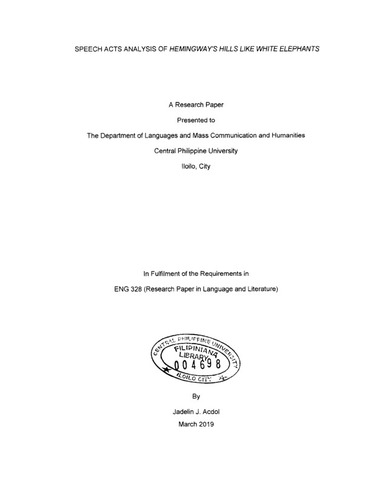Speech acts analysis of Hemingway’s Hills like White Elephants
| dc.contributor.adviser | Parcia, Gleason B. | |
| dc.contributor.author | Acdol, Jadelin J. | |
| dc.date.accessioned | 2023-11-10T08:41:52Z | |
| dc.date.available | 2023-11-10T08:41:52Z | |
| dc.date.issued | 2019-03 | |
| dc.identifier.citation | Acdol, J. J. (2019). Speech acts analysis of Hemingway’s Hills like White Elephants [Unpublished special paper]. Central Philippine University. | en_US |
| dc.identifier.uri | https://hdl.handle.net/20.500.12852/2862 | |
| dc.description | Abstract only | en_US |
| dc.description.abstract | This study examined Hemingway’s vignette, Hills Like White Elephants to determine the following objectives: 1) Identify the type of sentence represented by the utterances, 2) Determine the type of speech act represented by each utterance (direct or indirect) 3) Identify the illocutionary act performed by each utterance such as commissives, expressives, directives, declaratives and representative, 4) Determine the most dominantly used type of speech act in the vignette, and 5) Determine the most dominantly used illocutionary act. Speech Act theory was used in analyzing the vignette. It was found out that the percentage of illocutionary that were used are Representatives 44%, Expressives 8%, Directives 43% and Commissives 6%. The result showed that most of illocutionary acts occured in the were Representatives followed by the Directives. Through the analysis, it was the direct speech act with (97) utterances were highly used out of the total number of utterances in the whole text (101). There were only (22) utterances that use indirect speech act. Most of the utterances were direct type of speech acts and had one-on-one relationship with the illocutionary acts performed in the sentence. It was also found out that most requests did not take their normal imperative form. Intead, they took the interrogative or declaration. Commissives like offers and invitations also used the interrogative indirectly instead of the imperative or declarative forms they were meant to take. Some sentences seem almost to be conventionally used as indirect requests. In cases where these sentences were uttered as requests, they still had their literal meaning and were uttered with and as having that literal meaning. | en_US |
| dc.format.extent | viii, 51 leaves | en_US |
| dc.language.iso | en | en_US |
| dc.subject.lcc | PN 73 .A23 2019 | en_US |
| dc.subject.lcsh | Hemingway, Ernest, 1899-1961 | en_US |
| dc.subject.lcsh | Criticism | en_US |
| dc.subject.lcsh | Speech acts (Linguistics) | en_US |
| dc.title | Speech acts analysis of Hemingway’s Hills like White Elephants | en_US |
| dc.type | Special paper | en_US |
| dcterms.accessRights | Not publicly accessible | en_US |
| dc.description.bibliographicalreferences | Includes bibliographical references | en_US |
| dc.contributor.chair | Romarate, Esther Rose A. | |
| dc.contributor.committeemember | Cagasan, Bernardo G. | |
| dc.contributor.department | Department of Languages, Mass Communication and Humanities | en_US |
| dc.description.degree | Bachelor of Arts major in English | en_US |


